Rearfoot Heel Surgery Cartersville GA
Many Conditions Affect the Rearfoot
It can be difficult to know when rearfoot heel surgery may be necessary.
Many conditions can affect the back portion of the foot and ankle. Fortunately, many of these problems can be resolved through conservative treatments.
However when pain persists or deformity occurs, surgical intervention can often help alleviate pain, reduce deformity, and/or restore the function of your foot or ankle.
Rearfoot Heel Surgery
Two common conditions that can cause pain to the bottom of the heel are plantar fasciitis and heel spur(s). Although there are many causes of heel pain in both children and adults, most can be effectively treated without surgery. When chronic rearfoot heel pain fails to respond to conservative treatment, surgical care may be warranted.
- Plantar Fasciitis is an inflammation of a fibrous band of tissue in the bottom of the foot that extends from the heel bone to the toes. This tissue can become inflamed for many reasons, most commonly from irritation by placing too much stress (such as excess running and jumping) on the bottom of the foot.
- Heel Spur(s) or heel spur syndrome are most often the result of stress on the muscles and fascia of the foot. This stress may form a spur on the bottom of the heel. While many spurs are painless, others may produce chronic pain.
Based on the condition and the chronic nature of the disease, rearfoot heel surgery can provide relief of pain and restore mobility in many cases.
The type of procedure is based on examination and usually consists of plantar fascia release, with or without heel spur excision.
There have been various modifications and surgical enhancements regarding surgery of the heel. Your podiatric physician will determine which method is best suited for you.
There are many other causes of heel pain, which has become one of the most common foot problems reported by patients of podiatric physicians.
Many of them have a basis in heredity, as do a lot of other foot conditions.
Among the causes are stress fractures and stress-fracture syndrome, entrapped nerves, bruises, bursitis, arthritis (including gout), deterioration of the fat pad on the heel, improper shoes, and obesity, just to name some.
Most of these conditions will be treated non-surgically, though surgery may be recommended in some instances.
Haglund’s Deformity (pump bump)
This deformity is characterized by a bony enlargement on the back of the heel.
Although not always painful, it may become so if bursitis develops near the Achilles tendon secondary to footwear irritation.
If attempts at shoe modification and other medical treatments fail to improve this condition, surgical correction may be beneficial. Based on X-ray evaluation and other tests or examinations, your podiatric surgeon will select an operative treatment to alleviate the condition.
Insertional Achilles Clarification/Spur
This deformity differs from Haglund’s deformity, in that spur formation or calcification at the insertion of the achilles tendon is the cause of pain.
Often associated with achilles tendinitis, this deformity can often be difficult to treat medically and therefore surgical treatment may be necessary in chronic cases.
There are many causes of this condition, including arthritis, but the most common appears to be overuse syndrome, where trauma occurs where the achilles tendon attaches to the heel bone.
Surgical treatment includes removal of the bone spur and/or calcification, along with repair of the achilles tendon.
Reconstructive Surgery
Reconstructive surgery of the foot and ankle consists of complex surgical repair(s) that may be necessary to regain function or stability, reduce pain, and/or prevent further deformity or disease.
Unfortunately, there are many conditions or diseases that range from trauma to congenital defects that necessitate surgery of the foot and/or ankle.
Reconstructive surgery in many of these cases may require any of the following: tendon repair/transfer, fusion of bone, joint implantation, bone grafting, skin or soft tissue repair, tumor excision, amputation and/or the osteotomy of bone (cutting of bones in a precise fashion).
Bone screws, pins, wires, staples, and other fixation devices (both internal and external), and casts may be utilized to stabilize and repair bone in reconstructive procedures.
Preoperative Testing and Care
As with anyone facing any surgical procedure, those undergoing foot and ankle surgery require specific tests or examinations before surgery to obtain a successful surgical outcome.
Prior to surgery, the podiatric surgeon will review your medical history and medical conditions.
Specific diseases, illnesses, allergies, and current medications need to be evaluated.
Other tests that help evaluate your health status that may be ordered by the podiatric physician include blood studies, urinalysis, EKG, X-rays, blood flow studies (to better evaluate the circulatory status of the foot/legs), and biomechanical examination.
A consultation with another medical specialist is sometimes advised by a podiatric physician, depending on your test results or a specific medical condition.
Postoperative Care
Surgery of the rearfoot requires close care following surgery.
To assure a rapid and uneventful recovery, it is important to follow your podiatric surgeon’s advice and postoperative instructions carefully.
Rest, ice, compression and elevation of your foot/ankle postoperatively is often advised. The usage of bandages, splints, casts, surgical shoes, crutches, or canes may be necessary after surgery.
Your podiatric surgeon will also determine if and when you can bear weight on an operated foot.
